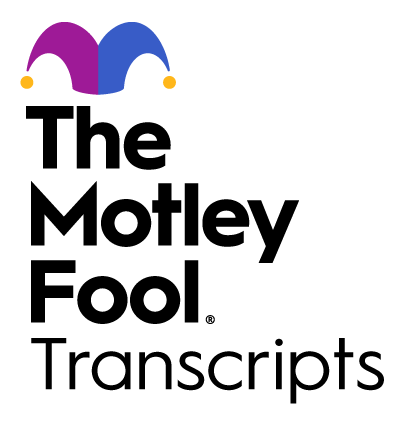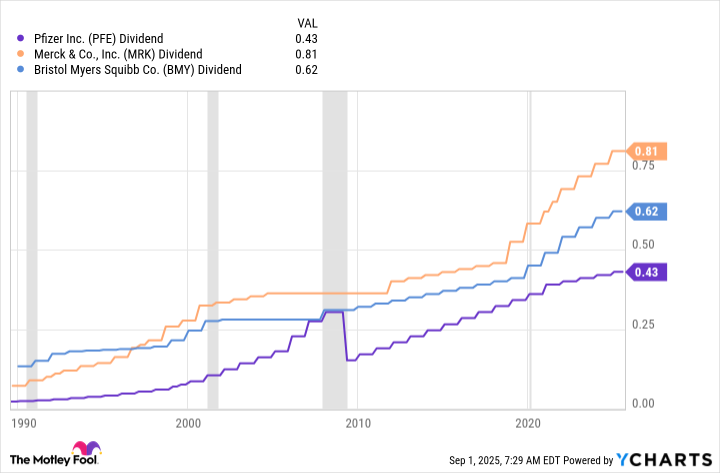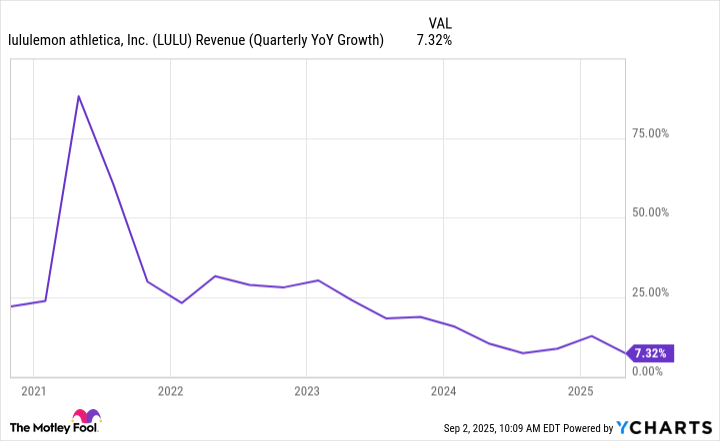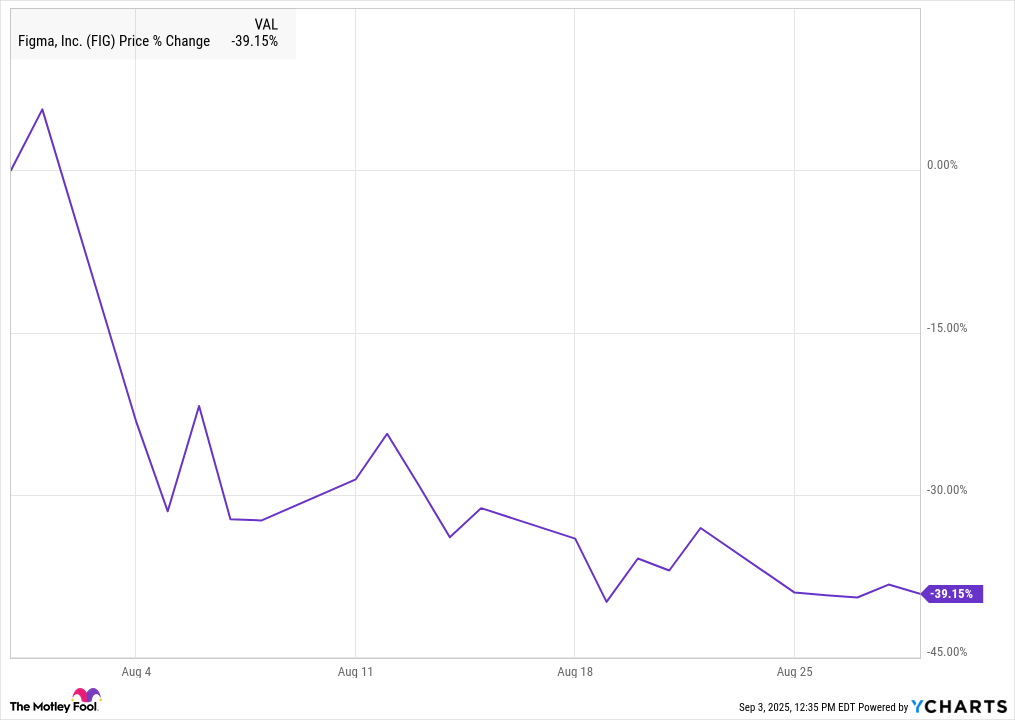
Image source: The Motley Fool.
DATE
Wednesday, September 3, 2025 at 5 p.m. ET
CALL PARTICIPANTS
President & Chief Executive Officer — Antonio Neri
Chief Financial Officer — Marie Myers
Head of Investor Relations — Paul Glaser
Need a quote from a Motley Fool analyst? Email [email protected]
RISKS
Marie Myers noted that networking operating margin declined to 20.8%, down 160 basis points year over year for fiscal Q3 2025 (period ended July 31, 2025), including both Intelligent Edge and Juniper, driven by variable compensation and product-related costs.
GAAP diluted net earnings per share of $0.21 was below guidance of $0.24–$0.29, with $326 million in net costs primarily attributed to Juniper-related acquisition costs, stock-based compensation, and amortization of intangibles, excluded from non-GAAP results.
Net leverage ratio increased to 3.1x pro forma post-acquisition at fiscal Q3 2025; management targets a reduction to around 2x by fiscal 2027, emphasizing debt paydown as a strategic priority.
Marie Myers highlighted that the inclusion of Juniper had an unfavorable impact on the cash conversion cycle, which increased to 35 days from last quarter, and noted “costs that I believe are commented on in Q3 and Q4 and also the increase in OI and E.”
TAKEAWAYS
Total Revenue— $9.1 billion, up 18% year over year and sequentially, with $480 million from one month of Juniper included.
Networking Revenue— $1.7 billion, up 54% year over year; Intelligent Edge revenue alone up 11% year over year, and the networking segment contributed nearly 50% of non-GAAP consolidated operating profit.
Annualized Recurring Revenue (ARR)— $3.1 billion, up 75% year over year including Juniper; Excluding Juniper, ARR grew 40% year over year, mainly driven by software and services.
Server Revenue— $4.9 billion, an all-time high, up 16% year over year and 21% sequentially, with AI systems revenue at $1.6 billion (up 25% year over year and 57% sequentially).
Operating Margin— Non-GAAP operating margin at 8.5%, down 150 basis points year over year, but up 50 basis points quarter over quarter (non-GAAP). Excluding Juniper, non-GAAP operating margin was 8.1% (down 190 basis points year over year, up 10 basis points sequentially).
Free Cash Flow— Free cash flow was $719 million, a significant sequential improvement aided by inventory reduction and higher AI backlog conversion.
AI Orders— Nearly doubled quarter over quarter, with sovereign AI orders up approximately 250% sequentially; record AI backlog at $3.7 billion.
Cost Synergy Commitment— Management affirmed at least $600 million in acquisition-related cost synergies over the next three years, with $200 million expected to be realized next year.
Guidance Updates— Full-year non-GAAP EPS outlook for fiscal 2025 raised to $1.88–$1.92. GAAP EPS revised to $0.42–$0.46 for fiscal 2025; projected constant-currency revenue growth of 14%–16% for fiscal 2025. Fiscal Q4 2025 networking revenue expected to be up over 60% sequentially due to full Juniper inclusion.
Hybrid Cloud Revenue— $1.5 billion, up 11% year over year; Segment operating profit dollars grew 26% with a 70 basis point increase in margin year over year.
SUMMARY
Hewlett Packard Enterprise(HPE 0.75%) reported record total revenue of $9.1 billion following the acquisition ofJuniper Networks(NYSE:JNPR), with all major segments experiencing year-over-year revenue growth and margin expansion in select product lines. Gross margin pressure emerged due to mix shifts in server, networking, and hybrid cloud. Networking became nearly half of consolidated non-GAAP operating profit, demonstrating outsized profitability from business realignment. Robust demand for AI offerings, with a record-setting backlog and new order growth, materially improved free cash flow, which helped lower inventories and better position working capital. Management reaffirmed synergy targets and improved its non-GAAP EPS outlook for fiscal 2025, while also explicitly highlighting the impact of acquisition-related costs and leverage on earnings and capital allocation.
CEO Neri stated, “Our improved profitability flowed through to non-GAAP diluted net earnings per share of $0.44.” near the high end of guidance for non-GAAP diluted net earnings per share, emphasizing earnings quality amid major portfolio shifts.
Management outlined plans for salesforce harmonization by year end, targeting synergy realization and expanded channel reach.
Marie Myers clarified that “free cash flow generation is paramount” underscoring debt reduction and restoring leverage ratios as HPE’s capital allocation priorities post-acquisition.
HPE’s ARR mix is increasingly tilted toward software and services, which now exceeds 81%.
Neri indicated HPE will detail its networking and longer-term AI strategy at the October Securities Analyst Meeting.
INDUSTRY GLOSSARY
ARR (Annualized Recurring Revenue): Run-rate metric measuring recurring subscription, service, and lease revenue accumulated over the prior quarter, scaled to a full year.
SASE (Secure Access Service Edge): Security framework that combines wide area networking (WAN) and network security services in a cloud-native offering.
AUP (Average Unit Price): Average selling price per unit, relevant for analyzing mix shifts and pricing trends in product segments.
SMB (Small and Medium Business): Segment of customers defined by Hewlett Packard Enterprise as organizations smaller than large enterprises, a key networking target.
Gen 11/Gen 12 servers: Hewlett Packard Enterprise’s eleventh and twelfth generation server platforms featuring new processor architectures and enhanced AI capabilities.
Full Conference Call Transcript
Operator: Good afternoon. And welcome to the Fiscal 2025 Third Quarter Hewlett Packard Enterprise Earnings Conference Call. All participants will be in a listen-only mode. Please note that today’s event is being recorded. I would now like to turn the conference over to Paul Glaser, Head of Investor Relations. Please go ahead, sir.
Paul Glaser: Good afternoon. I am Paul Glaser, head of investor relations for Hewlett Packard Enterprise. I would like to welcome you to our fiscal 2025 third quarter earnings conference call with Antonio Neri, HPE’s president and chief executive officer, and Marie Myers, HPE’s chief financial officer. Before handing the call to Antonio, let me remind you that this call is being webcast. A replay of the webcast will be available shortly after the call concludes. We have posted the press release and the slide presentation accompanying the release on our HPE Investor Relations webpage.
Elements of the financial information referenced on this call are forward-looking and are based on our best view of the world and our businesses as we see them today. HPE assumes no obligation and does not intend to update any such forward-looking statements. We also note that the financial information discussed on this call reflects estimates based on information available at this time and could differ materially from the amounts ultimately reported in HPE’s quarterly report on Form 10-Q for the fiscal quarter ended July 31, 2025. For more detailed information, please see the disclaimers on the earnings materials relating to forward-looking statements that involve risks, uncertainties, and assumptions.
Please refer to HPE’s filings with the SEC for a discussion of these risks. For financial information, we have expressed on a non-GAAP basis we have provided reconciliations to the comparable GAAP information on our website. Please refer to the tables and slide presentation accompanying today’s earnings release on our website for details. Throughout this conference call, all revenue growth rates unless noted otherwise, are presented on a year-over-year basis and adjusted to exclude the impact of currency. Antonio and Marie will reference our earnings presentation in their prepared comments.
Finally, I would like to clarify that in the discussion today, any mention of HPE Intelligent Edge will refer to HPE’s prior business segment and network will refer to the combination of Intelligent Edge and Juniper Networks. With that, let me turn it over to Antonio.
Antonio Neri: Thank you, Paul. Good afternoon, everyone. In Q3, we delivered solid results and completed a major milestone. Closing our acquisition of Juniper Networks. Together with Juniper, we will accelerate our momentum across our three strategic business pillars. Networking, cloud, and AI, building a stronger, leaner, and more profitable HPE. In Q3, HPE achieved record-breaking revenue with and without Juniper. Revenue was $9.1 billion, up 18% year over year fueled by strong momentum across AI, networking, and hybrid cloud. We grew revenues year over year across our three largest business segments. Demand was broad-based across our products and services. We increased sequential operating profit dollars in server hybrid cloud and both Intelligent Edge and the new combined networking segment.
We also grew operating profit dollars in financial services on a year-over-year basis. The new combined networking segment accounted for nearly 50% of HPE’s non-GAAP consolidated operating profit. We also improved sequential operating profit margins in server, and hybrid cloud. Our improved profitability flowed through to non-GAAP diluted net earnings per share of $0.44. Free cash flow was $719 million as we significantly lowered our inventory driven by higher AI backlog conversion to revenue and strong supply chain execution. We continue to transform our business through Catalyst, the structural cost-saving program we announced last quarter, including enhancing operational efficiency, simplifying our portfolio, adopting AI, and optimizing our workforce. In Q3, customers continued to demonstrate strong demand for our AI portfolio.
We nearly doubled our AI orders sequentially, driven by sovereign opportunities up approximately 250%. Cumulative orders since Q1 2023 for sovereign and enterprise now account for more than 50% of total AI systems net orders. We exited the quarter with record AI backlog at $3.7 billion. Marie will provide more details on the quarter and our Q4 fiscal year 2025 guide. But first, I would like to provide key Q3 highlights across our business segments. I am incredibly pleased that we closed the Juniper acquisition in July. Integration is progressing well. I have been spending time with Rami and the new combined networking leadership team, which is world-class.
Going forward, we will refer to the combination of our HPE Intelligent Edge segment and Juniper as our new HPE networking segment. Our vision for this segment is clear. To build the best network in business providing customers with a modern secure and AI-driven networking portfolio. Rami and I will discuss our networking strategy in more detail at our upcoming securities analyst meeting in October. On the demand front, the networking market recovery continues. In enterprise, we continue to see robust demand in campus and branch, driven by the wire and wireless refresh, SASE, and data center switching. Wi-Fi seven demand is ramping with orders up triple digits sequentially. In cloud, we see strong demand for networking for AI.
Particularly in data center switching and Juniper PTX routing. Revenue of $1.7 billion increased 54% year over year driven by strong performances in both Intelligent Edge and Juniper. Intelligent Edge revenue increased 11% year over year and 8% quarter over quarter. We generated double-digit year-over-year revenue growth in Campus and Branch, data center switching, automated one, and services. We also grew SASE and security revenue. These strong results contributed to sustained momentum in networking SaaS support services. Operating profit for the networking segment was $360 million up 43% year over year. Benefiting from one month of Juniper results and operating profit dollars expansion in Intelligent Edge. Networking innovation is accelerating across the entire networking portfolio.
Just last week, we introduced new Mist AgenTiC AI native innovations for campus and branch data center switching and automated one. These complement the new agentic AI mesh technology from our HPE Aruba networking portfolio that we announced alongside GreenLake Intelligence at HP Discover in June. Our innovation is being noticed by the market. HPE and Juniper Networks were both recognized again as leaders in the latest 2025 Gartner Magic Quadrant for Enterprise wire and wireless LAN infrastructure. Customers are already taking advantage of the power of our full HPE portfolio with the inclusion of HPE Juniper solutions. For example, early this year, HPE won a multimillion-dollar deal with Spar Austria Group. A leading retailer in Central Europe.
SPAR is building out a digital business services platform underpinned by GreenLake. The full IT stack solution is designed and implemented by HPE Professional Services. It will be fully managed by HPE managed services and includes Aruba switches, Juniper firewalls, Alletra MP storage, plus HPE Clouds ops software including Zerto, OpsRamp, and Morpheus. The solution will enable a cloud-native and AI-driven platform experience. Finally, with respect to integration synergies, we are reiterating at least $600 million in cost synergies over the next three years. In the server segment, market demand is robust across our portfolio.
Revenue of $4.9 billion was an all-time high, increased 16% year over year and 21% quarter over quarter driven by strong conversion of AI orders and solid demand for traditional servers. AI systems revenue of $1.6 billion was also an all-time high. As we completed delivery of a large GB 200 system. Server operating margin improved sequentially benefiting from the changes we made in pricing and discounting early in the year. Which returned traditional server product margins to historical levels. This was partially offset by higher AI mix, including a large deal. As we enter Q4, we continue to expect total server operating margin to be around 10% for the quarter.
AI systems orders increased nearly 100% quarter over quarter, including Middle East sovereign winds and continued traction in enterprise. We have grown enterprise AI orders year over year every quarter. Since the beginning of fiscal 2024. From an innovation perspective, we continue to keep pace with new accelerators technology and time to market customer demands. Last month, we launched HPE servers with the new NVIDIA Pro 6,000 Blackwell and NVIDIA Blackwell Ultra accelerated computing platforms. In traditional servers, customers are continuing to refresh edge infrastructure with more powerful, richly configured servers. As a result, revenue increased double digits year over year on mix shift to HPE Gen 11 and Gen 12 servers.
During the quarter, we expanded the Gen12 compute portfolio to include the latest AMD fifth-generation EPYC processors. The new servers include support for HP compute management with AI-driven lifecycle management. We expect the Gen 12 adoption to accelerate through 2026. In Q3, we also released our next HP nonstop compute solutions for mission-critical workloads. We doubled the memory capacity and doubled the system interconnect bandwidth. Finally, hybrid cloud performance was solid. Revenue of $1.5 billion increased year over year for the fourth consecutive quarter. In addition, operating profit margins were up 70 basis points and operating profit dollars increased 26% year over year. ARR increased 75% compared to Q3 2024 with the inclusion of one month of Juniper results.
On an organic basis, AIR increased 40% in line with our guidance of 35% to 45% CAGR. In storage, we saw robust growth in our IP product portfolio. HPE Alletra MP storage revenue increased triple digits year over year. We have now shipped more than 5,000 Alletra MP arrays to date. We continue to successfully migrate our customer installed base while gaining new customer logos resulting in a one-point gain in the most recently released IDC market share report. Private cloud, we continue to ramp sales of our enterprise AI factory solutions. During Q3, we added twice the number of new private cloud AI customers compared to Q2 with particular interest in our developer configuration.
Software is a core differentiator for our GreenLake cloud for our private cloud portfolio, which is a key contributor to our AIR growth. In June, we announced our new HPE hybrid cloud ops suite software bringing together Morpheus, VM Essentials, OpsRamp, and Zerto. To assist customers from hybrid cloud orchestration virtualization, and observability to continuous data protection. Our cloud software revenue in the quarter increased strong double digits year over year. At Discover Las Vegas, we unveiled GreenLake Intelligence. Our framework for deploying AI agents across cloud and infrastructure to simplify customers’ hybrid IT operations. We also expanded our agentic AI capability in OpsRamp networking and storage. Innovations like these continue to attract new customers to our GreenLake cloud.
In Q3, we added approximately 2,000 new customers bringing our GreenLake cloud customer count to approximately 44,000. In closing, as we look ahead, I am excited for HPE’s next chapter. The completion of our Juniper acquisition, positions us to win in networking as the market enters a new era of IT and business transformation where AI cloud and networking converge. We launched a new brand for HP to reflect this potential. The brand is modern, expresses what our technology and talent make possible and reinforces our relevance with our customers. Our vision for the company is clear. To lead in the AI era through a modern secure cloud-native and AI-driven networking portfolio that accelerates our profitable growth.
We are focused on executing with precision capitalize on the growing opportunities in the market, deliver strong value to our customers and our shareholders. I look forward to providing more details about our strategy our long-term value creation framework at our Securities Analyst Meeting on October 15 at the New York Stock Exchange. I would like now to turn it over to Marie to provide more insights into our quarterly results and full fiscal year guide. Marie?
Marie Myers: Thank you, Antonio, and good afternoon. I’m pleased with our performance this quarter while navigating an evolving market environment. Regarding our results, first, all segments of our business performed well. Our server business has moved past the pricing and discounting issues we reported earlier this year in compute. Hybrid cloud posted its fourth consecutive quarter of year-over-year top-line growth and operating margin expansion. And revenue growth in our Intelligent Edge business is improving as the networking market recovery continues. Second, I’m pleased that we completed our acquisition of Juniper, which will shift our revenue mix towards a higher growth higher margin networking business.
We continue to expect the acquisition to be accretive to our non-GAAP results in year one, enhancing our profitability as we capture synergies and drive new market opportunities with our increased scale. And finally, we made solid progress on our cost reduction initiatives announced last quarter. I’m looking forward to sharing more about the next chapter of our company at our security analyst meeting next month. Let’s talk about the details of the quarter. Third-quarter revenue of $9.1 billion which included Juniper, was up 18% year over year and quarter over quarter. And up 11% excluding Juniper revenue of $480 million. Excluding Juniper, total revenue of $8.7 billion exceeded the high end of our outlook range.
Demand was strong this quarter, and we did not see material demand pull in. Our reported annualized recurring revenue run rate was $3.1 billion including $590 million contributed by Juniper. Reported ARR was up 75% year over year or up 40% excluding Juniper. Software and services ARR, including Juniper, doubled year over year as the mix of this higher margin revenue improves sequentially by 640 basis points to over 81%. Including Juniper, non-GAAP gross margin was 29.9%, down 190 basis points year over year and up 50 basis points quarter over quarter.
On a year-over-year basis, gross margin was impacted by an unfavorable mix within server, networking, and hybrid cloud, which more than offset the benefit margin contribution from one month of Juniper. Excluding Juniper, gross margin was 28.3%. Non-GAAP operating expense, including Juniper as a percentage of revenue, was flat sequentially and declined 40 basis points year over year, reflecting strong revenue performance and disciplined cost management, partially offset by variable compensation. We will continue to manage costs rigorously as we target efficiencies through Catalyst, complemented by at least $600 million at expected Juniper-related cost synergies over the next three years with $200 million expected to be realized next year.
Excluding Juniper, non-GAAP operating expense as a percentage of revenue was 20.2%, down 160 basis points year over year and down 120 basis points sequentially. Driven by strong cost discipline as we grew revenue faster than expenses. Non-GAAP operating margin, including Juniper, was 8.5%. Down 150 basis points year over year primarily due to lower gross margins partially offset by cost management. The 50 basis point sequential improvement was primarily due to the inclusion of Juniper’s results. Excluding Juniper, operating margin was 8.1%, down 190 basis points year over year, but up 10 basis points sequentially.
During the quarter, we generated free cash flow of $790 million including approximately $200 million of deal-related costs, and higher net interest expense, partially offset by improved inventory management. Non-GAAP diluted net earnings per share of $0.44 was toward the high end of our guided range of 40 to 45¢. Our non-GAAP diluted net EPS includes a $0.01 net attributable to consolidating one month of Juniper’s results and the impact of net interest cost related to the acquisition. Q3 GAAP diluted net earnings per share was $0.21 below our guidance of $0.24 to $0.29.
In terms of these results, non-GAAP diluted net earnings per share excludes $326 million in net costs primarily due to Juniper-related acquisition costs, stock-based compensation expense, amortization of intangible assets and acquisition disposition, and other charges. Partially offset by adjustments for taxes, gain from litigation settlement, and other adjustments. Now let’s turn to our segment results. Starting with networking, As previously mentioned, we closed our acquisition of Juniper on July 2. So our Q3 earnings report includes only one month of Juniper’s results. Our Q4 networking results will include our first full quarter of consolidated Juniper financials. We will provide more details regarding our near-term and longer-term strategy and outlook for our networking business and our security analyst meeting.
Next month. Networking revenue for the quarter was $1.7 billion, up 54% year over year up 48% sequentially, and up 11% year over year, excluding Juniper. Strong networking revenue growth was driven by the ongoing recovery in the networking market and consolidation of Juniper’s results for the month of July. While it’s early days, we are pleased with our order growth, and revenue performance we generated across the combined networking business. Reported orders grew strong double digits year over year, including double-digit growth in both campus switching and the SMB markets. Excluding Juniper, Intelligent Edge orders grew a mid-teens percent year over year, Demand in Q3 was strong as sellout increased sequentially and year over year.
Networking operating margin was 20.8%, down 160 basis points year over year. This is inclusive of a 22.7 operating margin from HPE’s former Intelligent Edge business and 15.8% operating margin from Juniper’s networking business. Excluding Juniper, operating margin was down 90 basis points sequentially primarily due to variable compensation, and product-related costs. Server revenue was $4.9 billion, up 16% year over year and up 21% sequentially, above the high end of our guidance range. The quarter-over-quarter revenue increase was driven largely by a double-digit increase in AI systems revenue due to a large AI deal we shipped in the quarter. Augmented by higher AUP from a favorable mix shift in core compute.
In traditional server, revenue increased sequentially driven by volume increases and AUP strings supported by the continued shift to Gen 11 service. Augmented by early yet improving sales of our Gen 12 service. In AI systems, we signed $2.1 billion in net new orders, driven by robust growth in sovereign net new orders, which increased by triple digits both year over year and sequentially, while enterprise net new orders were also up year over year. Together, enterprise and sovereign constitute greater than 50% of our cumulative AI orders since Q1 2023. We generated $1.6 billion of revenue during the quarter up 25% year over year and up 57% sequentially.
Driven by the previously disclosed large AI system that we shipped in the quarter. We finished Q3 with our pipeline at multiple of our $3.7 billion ending backlog. Server operating margin of 6.4% was consistent with our outlook. Margin performance improved sequentially benefiting from the changes we made in pricing and discounting earlier in the year which returned traditional server product margins to historical levels. This was partially offset by higher AI mix, including a large deal and AI inventory. Moving to hybrid cloud. Revenue was $1.5 billion, up 11% year over year the fourth consecutive quarter of double-digit growth. Sequentially, revenue increased 1% consistent with our outlook.
In storage, our HPE Eletro MP platform continues to drive robust growth, achieving triple-digit year-over-year revenue growth for the third consecutive quarter while high double-digit margins expanded sequentially again. In Q3, new logos were up more than three hundred and fifty and grew over 70% year over year. In private cloud, revenue grew strong double digits year over year as we see continued growth in our pipeline for PCAI, where the number of new enterprise customers doubled quarter over quarter. Also, our VM Essentials solutions closed over 120 customers in Q3 and has generated a pipeline exceeding 1,000 interested since its launch last November.
Hybrid cloud operating margin increased 50 basis points sequentially to 5.9% and increased 70 basis points year over year the fourth consecutive quarter that our OP margin has expanded on a year-over-year basis. Lastly, our financial services business generated revenue of $886 million down 1% year over year and flat quarter over quarter. Financing volumes increased 2% year over year to $1.5 billion. Our Q3 loss ratio was 0.7%, and return on equity improved sequentially and year over year to 17.7%. Operating margin of 9.9% increased 90 basis points year over year primarily due to a higher mix of financing versus operating leases. But declined 50 basis points quarter over quarter driven by unfavorable operating expenses despite the higher revenue.
Last quarter, we announced Catalyst, a series of initiatives designed to accelerate growth. Increase efficiency, and make it easier to do business with HPE. Our starting point was at approximate 5% workforce reduction from the exit of Q1 with gross savings of at least $350 million by fiscal year 2027. We are executing well against our plan and expect to achieve our target of 20% of the total savings by fiscal year end 2025. We are taking an AI-first approach to reimagine our key workflows I have started in my own finance organization leveraging AI to increase productivity. Turning to cash flow and capital allocation.
We generated $1.3 billion of operating cash flow in the quarter and free cash flow was a positive $719 million a significant improvement sequentially as expected. At the end of fiscal Q3, inventory totaled $7.2 billion down $933 million sequentially, Excluding July ending Chewterbury inventory of approximately $1 billion Q3 ending standalone HP inventory was $6.2 billion down $1.9 billion sequentially. Reducing inventory levels has been a key priority and we exited q with our balance near our normalized level. Our Q3 cash conversion cycle was positive thirty-five days, up nine days from last quarter.
The inclusion of Jurupa unfavorably impacted our CCC calculation this quarter as it includes only one month of Juniper’s revenue and cost of sales results versus the consolidation of Juniper’s July ending balances. This timing issue obscures both the progress we made improving our CCC and the positive contributions for working capital the business generated on a sequential basis when excluding Juniper. We expect our CCC will improve in Q4 four with a full quarter’s consolidation of Juniper’s financials. As we expect the amount of free cash flow we generate to increase sequentially consistent with typical seasonality.
We returned $171 million to shareholders through dividends but were unable to repurchase shares during the quarter because we were in possession of material non-public information that we have since disclosed. As we prioritize debt reduction, we remain committed to our dividend policy and expect quarterly share repurchases comparable to levels reported in the 2025, partially offsetting share dilution resulting from stock-based compensation. At quarter end and including incremental debt associated with the transaction, our pro forma combined net leverage ratio was 3.1 times. We remain committed to our investment-grade credit rating and intend to reduce our net leverage ratio back to our target in the two times range by the 2027. Now let’s turn to guidance.
We are revising our FY 2025 outlook to incorporate four months of contributions from Juniper Networks. For revenue, we expect constant currency growth of 14% to 16%, estimate currency impacts of 30 basis points up nominally versus last quarter’s estimate. With the inclusion of Chudapur, we expect our non-GAAP gross margin outlook for Q4 to be in the mid-thirty percent range and fiscal 2025 to be above 30%. We expect operating expense to increase sequentially driven by full quarter inclusion of Juniper.
We expect full-year non-GAAP operating margin to be in the upper 9% range at the midpoint benefiting from a sequential improvement in Q4 to the upper 11% range driven by the continued improvement in server margins and the accretive contributions from Juniper. We are revising our FY 2025 GAAP EPS range to $0.42 to $0.46 which includes the impact of Juniper. Are raising our non-GAAP EPS range to $1.88 to $1.92 which reflects accretive contributions from Juniper though minimal for the year. We are reaffirming our estimate of a 2¢ impact from tariffs in the second half of the year. Lastly, we are revising our free cash flow outlook to approximately $700 million.
Excluding Juniper, we expect to generate approximately $1 billion of free cash flow in line with the guidance we provided last quarter. Through the end of Q3, year-to-date free cash flow was a $934 million use of cash. We expect Q4 free cash flow to be up materially quarter over quarter due to better net earnings, in addition to favorable working capital driven by significant improvements in accounts receivable collections. For Q4, we expect revenue to be between $9.7 billion and $10.1 billion. For networking, we expect revenue will be up over 60% quarter over quarter, reflecting a full quarter of Juniper. Expect our networking operating margin in Q4 and fiscal 2025 to be in the low 20% range.
For hybrid cloud, we expect revenue to be roughly flat quarter over quarter with a sequentially improved operating margin in the mid to high single digits. For server, we forecast a mid to high single-digit decline in revenue quarter over quarter driven by a greater than 30% sequential decline in AI systems revenue Following the large deal that shipped in Q3. We expect server operating margin to improve sequentially to around 10% for the quarter, reflecting continued momentum behind our improved execution and an improved mix towards enterprise and sovereign as we continue to focus on profitable growth.
Going forward, we will remain focused on profitable growth in the service segment we’ll continue to assess the optimal balance between volume growth, and margins. We expect GAAP diluted net earnings per share to be between $0.50 and $0.54 and non-GAAP diluted net earnings per share to be between $0.56 and $0.60. Our Q4 EPS outlook reflects a sequential increase in diluted shares outstanding to 1.44 billion, attributable to the conversion of Juniper-related stock-based compensation shares and forward awards. Following the acquisition of Juniper, we now expect Q4 OI and E in the $180 million to $200 million range. We expect Q4 free cash flow to be up sequentially, reflecting typical seasonality, favorable working capital, and increased net earnings.
With that, I look forward to seeing you at SAM in October. And now let me open the floor for questions.
Operator: Thank you. We will now begin the question and answer session. And your first question today will come from Aaron Rakers with Wells Fargo. Please go ahead. Yes. Thanks for taking the question and congrats on the close of the Juniper acquisition.
Aaron Rakers: I guess I want to just dive a little bit deeper into the server margin profile that you guys see. I think Antonio, in your prepared comments, you said that we’ve returned to more of a normalized operating margin on the traditional server line. I guess if I look back, I would assume that’s kind of in that low double-digit, let’s call it, 11% to 13% range I guess if I’m to do that math, it leads me to question the profitability of the AI server business. And so I guess, you know, as you think about that 10%, maybe you can unpack the drivers of getting to that level.
And I you know, how should we think about that AI server you know, margin profile? Thank you.
Antonio Neri: Thank you, Aaron, for the question. First, we are very pleased with the progression we made between Q1 to Q2 to Q3 based on the challenges we experienced in Q1 with price and discounting and as you said, we resolved those issues and the traditional server is back to historical levels around 10-12% as you talked about it. We believe that’s consistent with we see going forward. Remember there is a mix shift in addition to those pricing and discount changes. To GEN-eleven and GEN-twelve the structural of those products is different than gen 10 or gen 10 and a half. Obviously, it has higher AUP, different attach rates and the like.
And that’s gonna be a core foundation as we enter Q4. For delivering at the total server segment the around 10% for the quarter. Now this quarter obviously the mix of AI and in particular one deal and the work we did on inventory had a short term impact that ultimately took that what I call the overall server down to the 6.4% but as we exit that which already recognized then you’re going to get the natural lift into that higher single digit to close to 10%. And then therefore also you have the mix of sovereign and enterprise in the AI revenue conversion.
Because as we move from more a server provider centric revenue conversion to more a sovereign and enterprise revenue conversion in AI obviously we’re going to convert less in aggregate numbers it’s gonna have a different margin profile. And that’s why Maria and I the team are very confident that in Q4, the total server operating margin will be around 10%. So that’s the walk. Aaron.
Marie Myers: I’d just add, Aaron, we also have a robust internal framework that guides us in how we evaluate these AI related deals and prioritize them as well.
Operator: Very good. Thank you, Aaron. Operator, next question please.
Operator: Your next question today will come from Wamsi Mohan with Bank of America. Please go ahead.
Wamsi Mohan: Yes. Thank you so much. Now that Jennifer is closed, can you maybe just talk about some of the early progress on integration and go to market changes that we should expect? And any top line synergies and early customer feedback And Marie, maybe if you could talk about just the longer term opportunity for HPE in AI or Antonio. Just relative to networking versus servers, where do you see the larger opportunity for AI both from a revenue TAM and from a margin or profitability standpoint? Thank you so much.
Antonio Neri: Thank you, Wamsi. So first, we are incredibly pleased we closed the transaction of Juniper I think it was closed at the right time because obviously market recovery is taking place but also we see demand across sub segment of the networking market. And as we commented during my remarks and Marie’s remark, every subsegment on networking had a very strong performance. Whether it was HPE Intelligent Edge standalone or Juniper standalone and obviously on a combined basis, it’s even very, very strong. If you look at Compass and Branch, both companies are doing very well. Both company growing double digits, so that’s very strong. In data center switching and we talked about this during the July 9 call.
Juniper had that record breaking performance in data center switches and also a very good performance in routing which we call it the automated one Security was also up in the single digit year over year revenue growth driven by SASE. Then progress we have made is that is very strong, meaning integration is progressing really well. We have a series of milestones which we call it the employee day one, which is onboarding the employees into our systems. That’s a combination of benefits and other things that have to take place.
And then we have the harmonization of the Salesforce which we call it sales day one and that takes place at the end of this calendar year We already are incentivizing both sales forces to sell both products. And I can tell you the channel community is super excited to be able to sell both products. Because the combination of both products allows them to cover every vertical, every use case in every geography. And the fact of the matter is that the complementarity of the two portfolio allows us to drive strong security integration in our stack in addition to the integration with the rest of the portfolio with server and storage.
So we will be able to talk more about this Wamsi the securities analyst meeting. Rami, will take center stage and walk through the strategy. Early views of the proverb map, how we are driving the Salesforce integration, including our channel ecosystem. And we believe that’s going to be an opportunity as we 2026 and then obviously 2728. Your question about AI, as I think about the AI space, I always ground on three very distinct customer segments. In the service provider segment, and model builders Our strategy is to lead with networking or AI. The opportunity is significant. Juniper is getting traction.
It’s becoming the de facto standard in many of those customers and the opportunity with HP is to expand that footprint. And then we will sell these server products in that unique segment where it makes sense from an accretion from a margin perspective and working capital perspective. If you go to the sovereign space, which we saw this quarter of 200 plus percent growth on a year over year basis, and that sovereign also includes Neo Clouds, We will lead with an integrated rack scale architecture. Meaning networking plus the server business and all the services that comes with it.
And that will allow us to cover multiple type of offerings as customers in that segment may have the need to drive optionality and flexibility. And we have unique conversations with our partners. Then in the enterprise space, through the AI factory engagement with our private cloud AI portfolio which this quarter added 300 plus new logos double from last quarter we will lead with a full integrated stack. And that’s what we did with NVIDIA, the integration. Their software with our GreenLake plus the integrated infrastructure with our IHP Proline and Cray for the GPUs and then our Alletra MP storage or fast object and file plus all the services around it. To lifecycle manage that solution.
So I think at the portfolio level we can service every segment and find the right balance but I think networking us make us now stronger in the AI space because one of the key elements of that IT stack is the network at scale Juniper brings amazing technology both for the data center switching and the routing piece because once you integrate this in a large AI deployment, you need to core aggregate all of this through the leaf and spine into the data center footprint. And that requires also a routing product. So more to come at SAM. Okay. Thank you, Wamsi.
Operator: Next question please.
Operator: Your next question today will come from Samik Chatterjee with JPMorgan. Please go ahead.
Samik Chatterjee: Yes. Hi, thanks for taking my question. Antonio, you talked about just following up here on the Juniper sort of line of topics. Your networking overall margins are taking a bit of a step down to the sort of low 20 range. Where the segment historically has been about mid-twenties. How should we think about with the synergy road map that you have when the segment gets back to that sort of mid-twenties level? Because some of the back of the envelope math and the synergies would suggest you could actually probably go north of that as well long term.
But maybe just lay out the road map for us in terms of how to think about the progress on the margin front from the new set of level that you have post consolidation of Juniper? And, Murray, if I can quickly squeeze in one on cash, get the headwinds terms of closing Juniper on the cash flow this year, but how should we think about of the impact in on next year’s cash flow in relation to any closing costs or integration costs?
Antonio Neri: So I will pass it to Marie because I think will be able to answer both questions.
Marie Myers: Yeah, no worries. Thanks Antonio. Hey Sami, good afternoon. So Just to preface my answer before I get started, I’m going to answer both questions in the context of Q4 and full year ’25 guide. We will provide longer-term update to your questions, particularly around cash as we get into security analyst meeting in early October. So let me unpack first of all, the networking margin rate. So in the quarter, as you recall, we integrated a month of Juniper’s results and our intelligent edge business. We combine them now into one segment called the networking segment. And the combined operating margins were twenty point eight. If you look I think your question was focused specifically at the edge business.
Edge margin, actually, I disclosed in my prepared remarks, was 22.7, and we did see a sequential reduction, and that was really due to two primary factors. One’s variable comp expense, and the other one product related costs. And I did guide the Q4 op range to the low twenties as we get into the quarter. And the reason for that Samik, is obviously Juniper’s rate was a few points below our Intelligent Ed business. So just bear that in mind as you think forward to the networking margin rates. Now with respect to your question on cash flow, you know, we’re confident in our guide for the year.
And I would just say, you think about cash, there’s puts and takes. Now, obviously, you brought up Juniper costs, and we will give more clarity on that as we get through to Sam. Even as we get into Q4, there’s obviously costs that I believe are commented on in Q3 and Q4 and also the increase in OI and E. So all of that taken into account when you think about cash flow. And I just add, look. You know, we are absolutely focused on free cash flow. We’ll give you a lot more detail as we head to security analysts. As you know, our leverage has gone up, and so free cash flow generation is paramount for us.
Antonio Neri: Thanks. I want to reinforce the last point. Because of the integration of Juniper, the ability to generate earnings but also pay down the debt. Our main focus going forward in addition to drive the right balance of growth and operating margins is really free cash flow generation. And so we will be able to talk more about this at some.
Operator: Thank you for the question, Samik. Operator, next question please.
Operator: And your next question today will come from Amit Daryanani with Evercore. Please go ahead.
Amit Daryanani: Good afternoon. Thanks for taking my question. I guess, Antonio, I wanted to get sort of go back to the networking discussion. It sounds like, know, both Intelligent Edge and also Juniper are doing fairly well from a revenue basis. Guess simplistically, do you think about the growth rates for the combined business as we go forward, if you think networking market grows five, 6% a year, how do you think HPE plus Juniper can do And then, you know, really over time, how do you think about product integration on a campus side between Aruba and Mist? Do you think we need to Mist to Aruba, or and have a single product?
Or you think you can have both the products support in the marketplace simultaneously? Thank you.
Antonio Neri: Yeah. Thanks, Amit. Rami and I and the team are very pleased with the momentum both businesses have in the market. That’s a reflection that both offers are very strong. And let’s remind ourselves that’s true for campus and branch but when you go to data center switching and, obviously, the one business that’s 100% Juniper Then in the security space, we have a robust security portfolio because we need to lead with a secure network approach and that’s inclusive of Juniper firewalls, and the secure access service edge or the SSC which both company have very strong offerings. As you recall, in 2020, we acquired Silver Peak. To drive the convergence between SD WAN and security.
But as I think going forward, our goal is to build the best network in business. And that means we’re gonna grow above market. And that’s the reality. We’re gonna explain how that’s gonna be the case over the next three years. And we have an opportunity across AI and cloud and across the infrastructure itself. When I think about the Campos and Branch question, we were very clear with Rami. We’re gonna thoughtfully integrate the Juniper platform and the Aruba Central platform because you need to think about that layer Everything below that, is very straightforward.
There is no confusion because the reality is that we have a very strong robust campus switching portfolio which obviously has a lot of that has the wire piece which is Aruba silicon then Wi Fi access points. I don’t think that’s too complicated, and we’re gonna show what that looks like. And then finally, is the extension into IoT probably five gs which obviously HPE has unique offers. That integration of the cloud and AI ops is where that experience will evolve. But we are not going to leave any customer behind. We’re going to sell both products and you’re gonna see an integration that suddenly happen over time through the AI ops layer.
And that’s the opportunity we have here. And the good news customers want both today and we can serve every market vertical and we can also deploy any type of solution whether it’s cloud based virtual private cloud, meaning sovereign and then on prem. And that’s the opportunity we have ahead of us. And then last but not least on the data center switching side, in addition to networking for AI, we are also working integration in the private cloud, portfolio with the software defined networking components that Juniper brings. Through Fidelma’s hybrid cloud ops suite And then obviously in our storage and server business which require the switch along the way.
Operator: Very good. Thank you, Amit. Operator, next question please.
Operator: Your next question today will come from David Vaught with UBS. Please go ahead.
David Vaught: Great. Thanks guys for taking the question. So Antonio, I want to go back to the networking piece and maybe Marie can chime in on this. I think you talked about the traction that Juniper is getting with some these AI model builders and sort of that part of the network. How much of sort of the opportunity to grow is predicated on traction with those customers? And then maybe along those lines, I think Marie mentioned some product related costs. Was that mix in the networking section? To more, you know, AI centric offerings?
And how do we think about that mix shift going forward from a more enterprise campus centric model to one more hopefully, one more towards an AI model building sort of cloud model going forward? Thank you. Yeah. Thank you.
Antonio Neri: No, the AI opportunity is across all the three segments I mentioned earlier. Right, in networking, which is the service provider where we have the vision to lead with networking there because there is unique value proposition performance, cost, simplicity, lifecycle management. And AI driven capabilities. When you go to the sovereign space, same thesis. That’s even more important because you now drive rack scale integration with the rest of the server business. And then at the enterprise layer, course, we want to integrate the Juniper switch in everything we do in cloud and AI going forward by giving customers choice and flexibility. So the opportunity for networking in AI is across all three segments.
Now in the service provider space, obviously once you lay down the simple analogy I made, you laid the pipes inside the data center and you connect the data center to the rest of the interconnect process then obviously you become the standard And then from that, that solution, hang these amount of GPUs that comes with those deployments.
And so this is why the opportunity is significant and the benefit for Juniper which already had good traction is access to a very a larger number of customers that were not able to access before because we are strategic in many deals Remember, we cover 172 countries and also our heritage in countries and geographies where our mix is shifted to those example Europe and Asia versus North America. There is an opportunity here as we integrate the Salesforce but also integrate the architecture.
Marie Myers: And then, David, just to add on to your question around the product cost that was actually in the Intelligent Edge business that I mentioned that was on a sequential basis. And it was related to a platform transition. Thank you.
Operator: Thank you, David. Operator, next question please.
Operator: Your next question today will come from Eric Woodring with Morgan Stanley. Please go ahead.
Eric Woodring: Hey, guys. Thanks so much for taking my question. Antonio, was wondering if you could maybe just take a step back and share some details on you’re hearing from customers, what you’re seeing in the pipeline as it relates to kind of end market growth for your three core end markets, networking, server, and end And really, what I’m trying to understand is, there are some maybe concerns that the markets could be rolling over. There’s a lot of age infrastructure that can be refreshed. What are you hearing from your customers about prioritizing those types of upgrades?
And from the HPE perspective, you know, if we put network into the side because you’ve talked ad nauseam there, just where do you see the biggest opportunity to take share with the core HPE portfolio in those respective end markets? Thanks so much.
Antonio Neri: Well, you, Eric, and welcome. I know you are starting the coverage of our company just few weeks ago. So we appreciate you spending time with us. My view is that the market is robust We saw that throughout the Q3 order linearity was very consistent. There was nothing unnatural despite sometimes the true tariffs, no tariffs, but Marie commented on that the net impact of that is very minimal for us. At this point in time. And I will say on the server side, let’s start with that. On the traditional server side. There is a refresh going on We saw double digits year over year revenue growth in traditional servers.
Customers are refreshing edge infrastructure with more richly configured servers because they can reduce space and cooling on an aggregate basis. So with introduction on Gen 12 servers, we demonstrate that we can replace seven gen 11 servers and 14 Gen10 servers. And at the same time reducing the power consumption by 65% in addition to increase the security in their because now we support our own internal aisle of seven, which is basically the quantum proof encryption. And so that’s an example of what we see. And that was consistent across all three geos.
Now, there we participate with discipline, and ultimately, it’s a question of volume and margins we demonstrated in Q3 that we can do after the challenge we had in Q1. That’s one example and we believe over time, we believe we are poised to potentially gain share in enterprise. In the hybrid cloud space, huge opportunity through the transition of the virtualization layer. One of the areas people are focused on AI obviously for good reasons, but I can tell you one of the most exciting areas we see is the ability for customers to update or change their virtualization layer because of the rising costs they have seen in the last call it two years.
We have an enormous amount of proof of concepts going on with our Morpheus and VM Essentials. What we really focus there is the conversion from POCs to revenue This quarter we had double digit growth in our entire software portfolio. Which includes ops ramp provides deep observability inside the data center and outside the data center in a multi and multi vendor so that they can use our AI co pilot capabilities that we built inside GreenLake reduce OpEx. So they can reduce OpEx on licenses and can reduce OpEx on running that infrastructure in the way it is observed. So that’s another example of growth that we expect. Private cloud is another areas we expect to grow.
And then storage on our transition to our IP portfolio. This was the third consecutive quarter of triple digits year over year revenue growth in AlletraMP Why that’s happening is because we architected a new platform. That’s totally disaggregated. That provides the most effective block solution for those structural databases while at the same time leverage the same infrastructure and grow that in a scale out architecture into the unstructured data for fast object which is necessary for training or fine tuning rack models especially if you do that on prem and then eventually to do file ingestion. That value proposition is resonating with customers That’s why we gained one point of share in the last report from IDC.
And then in networking, you’re right, we spoke of Notion but I do believe there is a transition anyway in the wire switching. Remember we grew triple digits in Wi Fi seven and when you go to WiFi seven also you need more power at the port level to support those access points. And I believe that’s going to be also another opportunity for us.
Operator: Very good. Thank you, Eric. Welcome. Last question please, operator.
Operator: And your final question today will come from Simon Leopold with Raymond James. Please go ahead.
Simon Leopold: Thanks for taking the question. I wanted to see if you could revisit the topic of Juniper’s position in AI. On the call you hosted in July, Rami had indicated that Juniper had landed some deals in the back end. I’m wondering if you could unpack and give us a little bit more detail on that particular part of the business. Thank you.
Antonio Neri: Yeah. Simon, I think Ron and team have done a great job in lending several customers to become the reference in the networking space above the deployment of NVIDIA Spectrum So obviously inside the rack you have Spectrum SpectrumX all the way down to the NBLINK. With the NVIDIA Blackwell GPUs and the Grace Hopper GPUs. But above that, we have become the standard in some of these very large deployments And we are in a number of conversations with Neo Clouds and other service providers where we want to become the standard in that space. That’s why we believe is a big opportunity in leading with networking for AI in that particular couple of segments.
And so that’s our strategy going forward. And then obviously that will make our servers more attractive because also we will have more integration of the rack scale the sovereign space. And Juniper when the transaction closed had a very nice backlog that they built prior to the acquisition and we expect to unwind up back and new orders as we go forward. And so Rami will be able to explain more about this as we go to the security analyst meeting from a pure architecture perspective and how we are approaching that from a sales perspective. So thank you. Yeah, sorry we’re running out of time but we appreciate your time today.
I hope you take away that we are executing with precision. That we have a clear vision for the company, I am and the management team is very excited about the next chapter of HPE after the closing of the Jouvert transaction. You see the results of Juniper in our numbers with just one month and we’re excited to share more about this when we get at the security analyst meeting in New York, which I know everybody’s wanting to get a framework for twenty six, twenty seven, twenty eight. But beyond that, I’m excited to share our vision and the strategy for the company with this amazing portfolio we built. Thank you very much for your time.
Operator: Conference has now concluded. Thank you for attending today’s presentation. You may now disconnect.




















